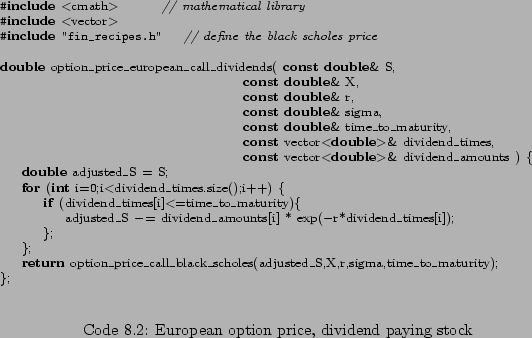Option pricing with discrete dividends using the Binomial Tree model
Post on: 29 Апрель, 2015 No Comment

Pricing European and American call and put options using the binomial tree model. Handles discrete dividends paid on underlying.
Introduction
This article builds upon the American option pricing model posted by Andrew Peters and lets you value options on stocks, futures, currencies, and stock indices with discrete or continuous dividends.
This project was written as part of my Options pricing class to create a Binomial Option Pricing model that could handle several types of options, including those on underlyings with discrete dividends.
The binomial options pricing model provides a generalizable numerical method for the valuation of options and was first proposed by Cox, Ross, and Rubinstein (1979). The model uses a discrete-time model of the varying price over time of the underlying financial instrument. According to this model, an option’s price at any moment in time can have two possible future states — up or down. Option valuation is then done via application of the risk neutrality assumption over the life of the option, as the price of the underlying instrument evolves. While the Black-Scholes-Merton formula requires that the option be European style, the Binomial models can handle American style options with ease. At any point of time, the value of the option is the maximum of the value calculated via its child nodes and the intrinsic value of the option. The Black-Scholes-Merton formula also assumes no dividend payouts while the Binomial model can handle dividend payments — thus making it flexible enough to handle currencies, stock options, futures, and index options.
Architecture
I created a BinomialTree class that is used for interfacing between the Windows Form and the TreeNodeFactory class. This class invokes the methods necessary to create the binomial lattice and do the aggregate calculations over it. The TreeNodeFactory is used to create objects of TreeNode. Each TreeNode instance represents — you guessed it — a node in the binomial tree.
The factory maintains an ArrayList of all the TreeNode objects it creates and allows you to create, fetch, and delete TreeNode s in the binomial lattice. The enumeration EnumStyle represents whether the option is American or European. The enumeration EPutCall from Andrew Peter’s code is used, and represents whether the option is a put or a call.
Building the price tree for the underlying security — no discrete dividends
In the code above — the step variable is used to represent a step in the binomial lattice. For instance — a 12 step lattice for an option maturing in one year would have each step of one month’s duration. The level is a representation of the row number. Since this is a lattice, the i th step would have i+1 levels. The first node — representing the current time — will be step zero and level 1. The next step would have two nodes -level 1 and 2, and so on.
Computing the option values
For the last step in the binomial lattice, the payoffs are calculated using the formula for intrinsic value of an option — Max(S-K) for calls and Max(K-S) for puts.
For nodes at all preceding levels, the node values are calculated using the maximum of either the intrinsic value, or the value calculated using:
or,
where CU is the value of the call option if the price moves up and CD is the value if the price moves down.
TreeNode handles these valuations and sets its option price:
Factoring in discrete dividends
While this model can handle continuous dividend yields by simply factoring that value into its calculation of p. handling discrete dividends requires some extra work. This approach is suggested by Hull in his excellent treatise on option pricing: Options, Futures, and other derivatives(6 th edition). We simply discount the present value of all dividends from the initial price of the underlying, when creating the tree. Then, at each node, we add the present values of the dividends at that point in time. We modify CreateStockPriceTree to the code below:
The code in TreeNode that adds back the dividend present values to the node’s stock price is:
Please note that in the entire project, the dates used are not calendar dates but lengths of time in years. If you want to extend it to use actual dates, it should be a trivial change.
The computation of option values proceeds in the same way for discrete dividends as it did before.
Feedback
I would be delighted to hear your comments, suggestions, or idle chatter. Please email me at tanveeransari@hotmail.com.














